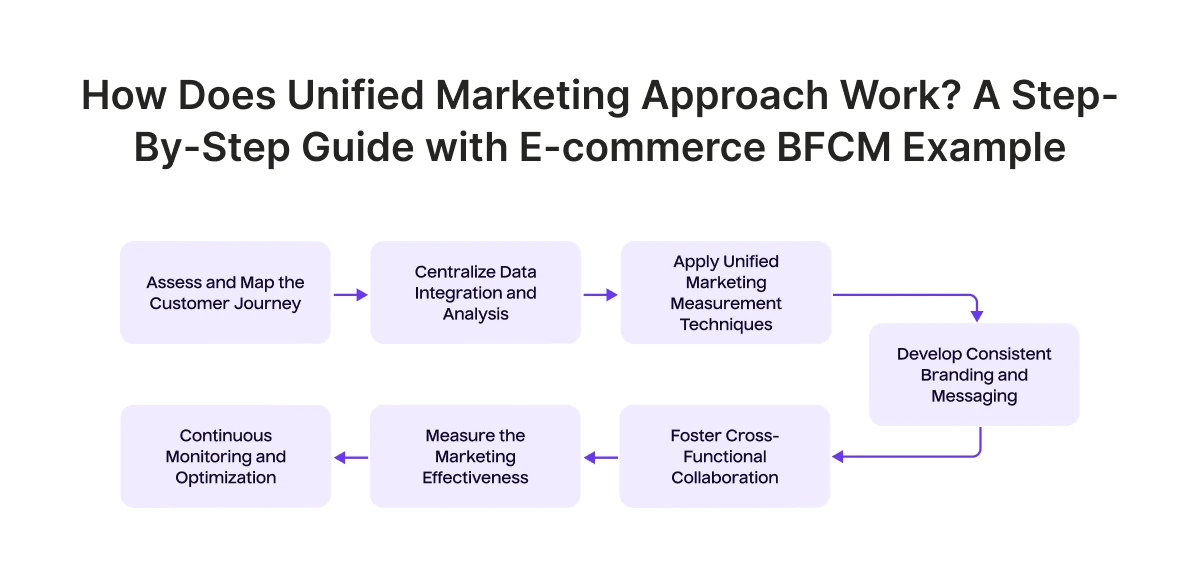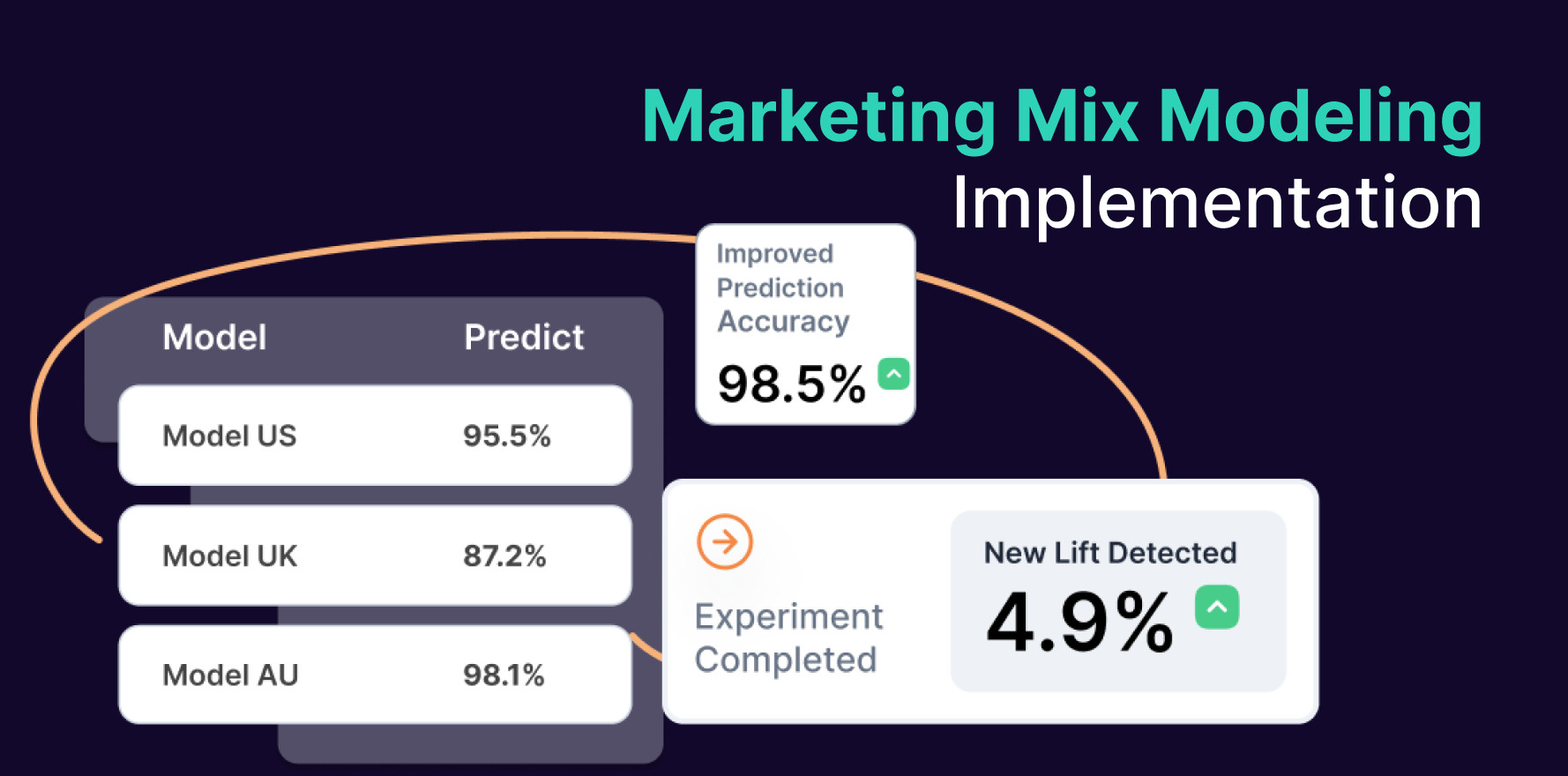What is Unified Marketing?
Unified marketing is a data-driven measurement approach that integrates all marketing channels, teams, tools, and data into a single unified model to deliver a consistent brand experience for customers across every touchpoint.
Rather than managing fragmented, disconnected tools, unified marketing centralizes data and operations, making it possible to track the entire customer journey across channels and multiple touchpoints, and to ensure that messaging, tone, and value remain consistent everywhere your audience interacts with your brand.
Ultimately, unified marketing helps businesses to understand the impact of their marketing activities and gain a comprehensive view of how all channels contribute to conversions. This enables smarter budget allocation and campaign optimization, rather than making decisions based on incomplete or misleading data from isolated tools.
Examples of Unified Marketing
An e-commerce company invests heavily across multiple marketing channels like Performance Ads, Instagram Ads, Facebook (Meta) Ads, YouTube Ads, Transit Ads, Out-of-Home (OOH) Ads, and TV Ads. Each channel uses its own tool to track campaign performance, typically relying on single-touch attribution models.
For example, if a customer ultimately purchases via a Google Search Ad, Google Ads will take 100% credit for the conversion, even if the customer previously saw Instagram, YouTube, or TV ads for the same product.
This siloed approach means the influence of Instagram, YouTube, and TV ads on the final purchase is ignored. As a result, the business might mistakenly believe those channels are underperforming and decide to cut their budgets, even though they played a crucial role in the customer’s decision-making process.
Unified marketing solves this problem by integrating data from all channels, both online and offline, into a single, holistic model. This approach combines methodologies such as Marketing Mix Modeling (MMM), Incrementality Testing, and Causal Attribution to measure the true, causal impact of each marketing touchpoint and how they influence one another.
For example, if there is a spike in Google Search conversions following a TV commercial or Instagram campaign, the unified model assigns credit based on demonstrated causal influence, not just correlation, accurately reflecting each channel’s contribution to the customer journey.
Why Should Business Consider a Unified Marketing Approach?
1. Fix Your Outdated Marketing Attribution
Move beyond the broken traditional multi touch attribution model and use Incrementality Testing and Causal Attribution to measure the true cause-and-effect impact of each marketing channel.
2. Eliminate Wasted Ad Spend
It helps to identify underperforming channels and campaigns that aren’t contributing to business outcomes. Reinvest budget into high-impact areas that drive measurable growth and profitability.
3. Understand Revenue-Driving Channels
Get a clear view of which marketing efforts lead to real revenue, not just vanity metrics like clicks or impressions. Focus on what truly moves the bottom line, including metrics like ROAS, iROAS, CAC, mROAS, CPL (Cost per Lead), and Incremental CPL.
4. Optimize Budget Allocation
Use performance data from a unified model to guide smarter budgeting decisions. Prioritize spend on channels that deliver the highest return on investment.
5. Enhance Campaign Effectiveness
Uncover which creative, messaging, timing, and placement strategies drive the best results across the entire customer journey. Continuously refine campaigns for better outcomes.
6. Centralize Data Management
Bring all marketing, sales, and customer data into a single system of record. Eliminate disconnected tools and manual reporting for faster, cleaner analysis.
7. Enable Cross-Channel Collaboration
Align teams across paid, owned, and earned media with shared goals and integrated data. Break silos to ensure cohesive planning and execution.
8. Drive Data-Informed Decisions
Replace guesswork with accurate, actionable insights. Make strategic decisions backed by unified analytics, historical performance, and real-time data.
9. Utilize Predictive Modeling
Forecast future performance, customer behavior, and campaign outcomes with confidence. Plan more effectively using machine learning and statistical modeling.
10. Ensure Brand Consistency
Maintain a unified brand voice and experience across all channels. Reduce customer confusion and build stronger brand equity through consistent messaging.
11. Improve Customer Experience
Deliver smoother, more personalized customer journeys by understanding cross-channel behavior. Meet your audience where they are, with what they need.
12. Enable Personalized Interactions
Leverage unified data to tailor content, timing, and messaging to individual preferences and behaviors. Improve engagement and conversion rates.
13. Adopt a Customer-Centered Approach
Shift from channel-centric to customer-centric marketing. Focus on what the customer experiences across the entire journey, not just within individual channels.
What Experts Say About Unified Marketing and Unified Marketing Measurement?
Adopting a unified platform that brings together marketing, sales, and customer service isn’t just a trend; it’s a necessity. Integrating these functions is vital for delivering a seamless customer experience and driving operational efficiency. The use of marketing automation and a robust CRM system empowers teams to better understand customer needs and personalize every interaction. Businesses that prioritize customer data and connection can build stronger relationships while streamlining their operations under one cohesive system. Unified platforms are clearly paving the way for smarter, more agile organizations.
~ Megan Grant, Senior Marketer, EngageBay
Source YT: The Case For A Unified Marketing, Sales & Service Platform
The conversation with Ovative’s Troy Neermeyer and Beth McKinney on the Omni Talk Retail podcast offers valuable insights into the importance of Unified Marketing measurement in the retail sector. Traditional metrics are no longer enough to capture marketing’s real impact. Ovative’s Enterprise Marketing Return (EMR) provides a more complete view by connecting marketing efforts to key business outcomes such as sales, customer acquisition, and profitability. The discussion reinforces the need to treat marketing as an investment rather than an expense. Unified Marketing also requires cross-functional alignment, especially with finance, and a strong culture of testing and learning to continuously improve results.
~ Ovative’s Troy Neermeyer, VP of Measurement and Enabling Solution, Ovative Group
Source YT: Why Unified Marketing Measurement Is Key to Business Success
How Does Unified Marketing Approach Work? A Step-By-Step Guide with E-commerce BFCM Example
An e-commerce company that sells fashion and lifestyle products online operates in a highly competitive market. With a large marketing budget spread across digital and offline channels year round, the brand continuously invests in platforms like Instagram, Google Ads, YouTube, email, and TV. While their campaigns generate strong engagement, the company struggled in 2024 to measure true performance and ROI across channels, especially during peak seasons like Black Friday and Cyber Monday (BFCM). To address this, they adopted a Unified Marketing Approach to improve attribution, optimize budget allocation, and drive smarter growth.
1. Assess and Map the Customer Journey
Begin by identifying and mapping every touchpoint where customers interact with your brand, both online and offline. This comprehensive view helps you understand the complete customer experience and spot any inconsistencies or gaps.
Example:
- Online: Website visits, Google Ads, Facebook/Instagram Ads, email campaigns, social media engagement, live chat
- Offline: In-store visits, TV ads, transit ads, call centers, events
This mapping reveals that many BFCM shoppers first see a TV ad, then interact with Instagram, and finally purchase via Google Shopping. Last year, without unified mapping, the company missed these cross-channel journeys.
2. Centralize Data Integration and Analysis
Consolidate all marketing data from various channels (digital, offline, CRM, etc.) into a single, unified platform. This centralization enables holistic analysis, accurate tracking, and a complete understanding of customer behavior across all touchpoints.
Example:
This year, all marketing data from digital ads, CRM, offline campaigns, and customer support is integrated into a single analytics platform. Marketers can now track how TV and Instagram ads drive traffic that later converts via email or Google Ads during BFCM.
3. Apply Unified Marketing Measurement Techniques
Once data is centralized, the next step is to apply robust, evidence-based measurement methodologies. These methods go beyond traditional attribution models that rely on last-touch credit or click-based paths. Instead, Unified Marketing Measurement uses causal approaches to understand what’s truly driving performance and incrementality.
The three core methodologies used are Marketing Mix Modeling (MMM), Incrementality Testing, and Causal Attribution.
a. Marketing Mix Modeling (MMM)
MMM analyzes historical, aggregated data across all marketing channels, while also factoring in external influences such as seasonality, holidays, pricing, promotions, and economic trends. It estimates the impact of each variable on key business outcomes such as sales, revenue, new customer acquisition, customer retention, profit margins, and marketing efficiency metrics like ROAS, CAC, CPL, iROAS, and mROAS.
Example:
MMM reveals that Instagram campaigns delivered a 2.4x iROAS during BFCM, but a significant portion of that lift was due to holiday demand rather than the ad alone.
How to use it:
Use MMM for strategic planning, identifying marginal returns, optimizing budget by channel, and adjusting spend post-BFCM when seasonal uplift no longer applies.
b. Incrementality Testing
Incrementality testing involves geo-based or holdout experiments to measure the actual lift caused by a campaign, channel, or tactic. This method isolates the effect of marketing by comparing test and control groups, rather than inferring from behavior alone.
Example:
In regions exposed to a new YouTube campaign during BFCM, sales increased by $300,000 with a $50,000 spend, resulting in an iROAS of 6x. However, because BFCM shoppers are more purchase-ready, this result may not replicate in Q1.
How to use it:
Use incrementality testing to validate MMM insights, measure lift by channel or creative, and make data-backed scaling or pausing decisions for future campaigns.
c. Causal Attribution
Causal attribution uses advanced statistical techniques to quantify the true influence of each touchpoint in the customer journey, avoiding the pitfalls of traditional multi-touch attribution (MTA).
Example:
A customer sees an Instagram ad, clicks a Google Shopping ad, and later converts after a cart abandonment email. Causal attribution shows Instagram increased conversion likelihood by 35%, email by 25%, and Google by 30%. This breakdown helps clarify where real influence occurred—especially useful during BFCM when multiple channels overlap.
How to use it:
Use causal attribution for daily or weekly campaign optimization, adjusting bid strategies and creative based on each channel’s real impact.
4. Develop Consistent Branding and Messaging
Ensure that your brand’s messaging, tone, visuals, and values are consistent across every channel and customer interaction. This cohesion strengthens brand recognition and trust.
Example:
All BFCM campaigns, from TV to Instagram to email, use the same visuals, offers, and messaging. Customers recognize the brand instantly, boosting trust and conversion rates.
5. Foster Cross-Functional Collaboration
Encourage collaboration between marketing, sales, customer service, and other relevant teams. Breaking down silos ensures everyone is aligned, shares insights, and works toward unified business goals.
Example:
Marketing, sales, customer service, and analytics teams meet weekly during BFCM to share real-time insights, adjust messaging, and quickly resolve any customer experience issues, ensuring a unified and agile approach.
6. Measure the Marketing Effectiveness
Track performance using unified metrics and KPIs across all channels. Analyze the data to determine what’s working, what’s not, and where improvements can be made.
Example:
Unified KPIs such as iROAS, CAC, customer retention, and new customer acquisition are tracked across all channels. The company can see which BFCM campaigns truly drove incremental sales and which just shifted demand from other channels.
7. Continuous Monitoring and Optimization
Regularly review campaign results, test new strategies, and refine your approach based on data-driven insights. This ongoing optimization ensures your marketing remains effective and responsive to changing customer behaviors and market conditions.
Example:
After BFCM, the unified measurement model continues to track performance in Q1.
Forecasting: The model predicts which channels will perform best in quieter months, such as email and retention campaigns being more effective than paid ads in January.
Budget Allocation: Insights from BFCM are used to adjust spend, test new offers, and plan for the next big sales event.
Learning: The company learns that certain BFCM tactics, such as deep discounts, are less effective post-holiday, so they shift focus to loyalty programs and personalized offers.
By following these steps, organizations can implement a unified marketing approach that delivers a seamless customer experience, maximizes marketing ROI, and drives sustained business growth
Automate Your Unified Marketing Workflow Today
In the next generations of marketing environments, manual processes and disconnected tools can slow down your ability to act on insights and scale growth. Automating your unified marketing workflow not only streamlines operations but also allows your team to focus on what truly matters: strategy, creativity, and performance.
Why Automation Matters?
Unified marketing depends on integration, collaboration, and speed. When you automate key components of your workflow such as data collection, model updates, budget recommendations, and reporting, you eliminate inefficiencies and reduce human error. Most importantly, automation ensures that decisions are based on the most accurate and up-to-date view of your marketing performance.
What Can Be Automated?
- Data Integration: Automatically collect and unify data from all sources including digital ads, CRM platforms, offline sales, and customer support into a single platform.
- Modeling and Measurement: Schedule regular refreshes for Marketing Mix Models (MMM), incrementality tests, and attribution models to maintain real-time insights.
- Insights and Alerts: Set up alerts to notify your team about performance shifts, budget inefficiencies, or campaign saturation.
- Optimization Recommendations: Automatically generate suggestions at the channel and campaign level using real-time data and predictive analytics.
- Reporting: Create and share dashboards with unified KPIs such as ROAS, CAC, iROAS, and customer retention. Customize reports for marketing, leadership, and cross-functional teams.
Benefits of an Automated Unified Workflow
- Faster Decision-Making: Access real-time insights without waiting for manual reports or delayed analysis.
- Improved Accuracy: Reduce data entry errors and ensure consistent measurement across departments.
- Agile Optimization: Reallocate budgets and adjust strategies quickly based on live performance indicators.
- Stronger Collaboration: Ensure all teams work from the same source of truth and stay aligned with shared goals.
How to Get Started?
- Select a Unified Marketing Measurement (UMM) platform that offers automation features.
- Connect all essential marketing and analytics tools to your central platform.
- Define thresholds for alerts, refresh frequencies, and reporting cycles.
- Automate data imports, model updates, and dashboard delivery to keep everyone in sync.
Best Unified Marketing Platform
Read More About: 5 Best Unified Marketing Platform
Best Unified Marketing Measurement Platform
- Lifesight’s Unified Marketing Measurement Platform
- Keen Decision Systems
- Measured UMM
- Funnel’s UMM
- Rockerbox
- Supermetrics
Read More About: What is Unified Marketing Measurement?
Get started with Lifesight Unified Marketing Measurement Platform Today
Tired of guesswork, siloed data, and unreliable attribution? It’s time to move from fragmented insights to clear, actionable decisions powered by unified marketing measurement.
Here’s how to take the first step:
1. Visit Our Home Page
Go to Lifesight and explore how brands like yours are transforming marketing with unified measurement.
2. Take the Product Tour
Navigate to our Product Tour section for a hands-on look at how our platform integrates MMM, Incrementality Testing, and Causal Attribution—automatically.
3. Book a Free Demo
Schedule your personalized walkthrough with one of our experts. See how Lifesight can centralize your marketing data, uncover real impact, and optimize spend with precision.
The aim of marketing is to know the customer so well the product fits them and sells itself – Peter Drucker
Conclusion
Unified marketing empowers businesses to move beyond fragmented tools and outdated attribution models by providing a clear, data-driven view of what truly drives performance. With centralized data, causal measurement, and automated insights, brands can make smarter decisions, maximize ROI, and deliver consistent customer experiences across every touchpoint. It is not just a strategy; it is the foundation for sustainable and scalable growth.
FAQ’s
1. How is Unified Marketing different from traditional marketing?
Unified Marketing integrates all channel data and efforts for a holistic, real-time view, while traditional marketing often operates in silos with fragmented measurement and limited cross-channel insights
2. Why is traditional attribution broken?
Traditional attribution models (like last-click) assign all credit to a single touchpoint, ignoring the true influence of multiple channels and leading to inaccurate performance insights.
3. What’s the difference between MMM, Incrementality Testing, and Causal Attribution?
MMM analyzes aggregated data to measure the impact of all channels and external factors, Incrementality Testing isolates true lift via experiments, and Causal Attribution quantifies the direct effect of each marketing activity on conversions
4. Can Unified Marketing be applied to both online and offline channels?
Yes, Unified Marketing consolidates data from both online and offline channels, providing a comprehensive view of marketing performance across the entire customer journey
5. How does Unified Marketing help with budget optimization?
It identifies the most effective channels and tactics, enabling smarter budget allocation and real-time adjustments for maximum ROI
6. Is Unified Marketing only for large enterprises?
No, businesses of all sizes can benefit from Unified Marketing by gaining better insights and improving marketing efficiency
7. How long does it take to implement a Unified Marketing Platform?
Implementation time varies based on data complexity and resources but can range from a few weeks to several months depending on organizational readiness
8. What KPIs can I track with Unified Marketing?
You can track metrics like sales, ROI, customer acquisition cost (CAC), retention, incremental revenue, and channel-specific performance
9. Is Unified Marketing compliant with data privacy regulations?
Yes, modern unified marketing platforms are designed to comply with data privacy regulations by centralizing governance and ensuring secure data handling
10. How does automation enhance Unified Marketing?
Automation streamlines data integration, campaign management, and reporting, enabling faster insights and more agile marketing decisions
Essential resources for your success




















































